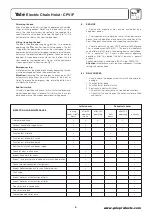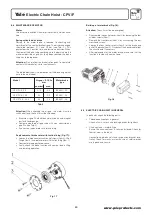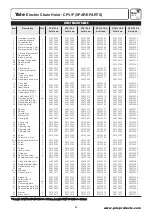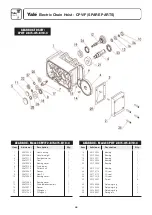
Yale
Electric Chain Hoist - CPV/F
®
3
www.yaleproducts.com
TABLE OF CONTENTS
PAGE
1.
General information
3
1.1 Decibel Levels
3
2.
Correct operation
3
Maximum capacity
3
Danger zones
3
Attaching the hoist / trolley
3
Temperature range
4
Regulations
4
Maintenance / repair
4
3.
Incorrect operation
4
4.
Assembly
4
4.1 Inspection before assembly
4
4.2 Electric chain hoist with suspension bracket
4/5
4.3 Electric chain hoist with trolley
5
Assembly of the trolley
5/6
4.4 Electrical connection
6
Preparation
6
Mains supply connection
6
4.5 Motor data
7
5.
Functional test after assembly
8
6.
Commissioning
8
Inspection before initial operation
8
7.
Operation
8
Installation, service, operation
8
Inspection before starting work
8
Inspection of load chain
8
Inspection of chain end stop
8
Inspection of chain reeving
8
Inspection of load hook
8
Attaching the load
8
Inspect the traverse (for trolleys)
8
Check adjustment of trolley width
8
Traversing the trolley
8
Attaching the load
9
Lifting / lowering the load
9
Emergency stop
9
Limit switch
9
8.
Service
9
8.1 Daily checks
9
8.2 Regular inspections, service and testing
10
8.3 Load chain
10
Lubricating the load chain
10
Inspecting the load chain for wear
10
Replace the load chain
10
1 fall design, 2 fall design
10/11
8.4 Maintenance of load hook
11
8.5 Maintenance of trolley
12
8.6 Maintenance of overload protection device
12
Overload protection
12
Adjustment of overload protection
12
8.7 Maintenance of gearbox
12
Oil change
12
8.8 Maintenance of motor
13
Motor
13
Spring activated disc brake
13
Changing of rotor with friction lining
13
Disassembly of disc brake
13
8.9 Electric chain hoist in general
13
9.
Inspection chart
14
10. Spare parts list
15-22
11. Wiring diagrams
22
12. EC Declaration of Conformity
23
1.
GENERAL INFORMATION
Attention:
All users must read these operating instructions carefully
prior to the initial operation. These instructions are intended to
acquaint the user with the hoist / trolley and enable them to use it to
the full extent of its intended capabilities.
The operating instructions contain important information on how to
operate the hoist / trolley in a safe, correct and economic way. Acting
in accordance with these instructions helps to avoid dangers, reduce
repair costs and downtime and to increase the reliability and lifetime
of the hoist / trolley.
Anyone involved in doing any of the following work with the hoist /
trolley must read the operating instructions and act accordingly:
• Operation, including preparation, trouble shooting and
cleaning.
• Maintenance, inspection, repair.
• Transport.
Apart from the operating instructions and the Health & Safety
Regulations, which are valid for the respective country and area where
the hoist / trolley is to be used, the commonly accepted regulations
for safe and professional operation must be adhered to.
The user is responsible for the proper and professional instruction of
the operating personnel.
Every unit leaving the factory is furnished with a test certificate that
shows the serial number of the hoist / trolley. This certificate has to
be filed together with the inspection manual to form a service file which
should be maintained throughout the life of the hoist.
1.1 DECIBEL LEVELS
The continuous sound level at the place of work is equal to >73dB.
The measurements were taken at a distance of 1 m from the hoist at
9 positions in accordance with DIN 45635, precision class 2.
2.
CORRECT OPERATION
Maximum capacity:
The Yale electric chain hoist series CPV/F has been designed to lift
and lower loads up to the rated capacity. The lifting capacity indicated
on the hoist / trolley is the maximum safe working load which must
not be exceeded.
Danger zones:
• Do not lift or transport loads
while personnel are in the danger
zone.
• Do not allow personnel to pass
under a suspended load ( Fig. 2).
• After lifting or tensioning, a load
must not be left unattended for
a long period of time.
• Start moving the load only after
it has been attached correctly
and all personnel are clear of the
danger zone.
Attaching the hoist / trolley:
The operator must ensure that the hoist / trolley is attached in
a manner that does not expose himself or other personnel to
danger by the hoist, trolley, chain(s) or the load.
Fig. 2
Yale
CPV/F
®



























